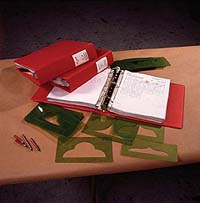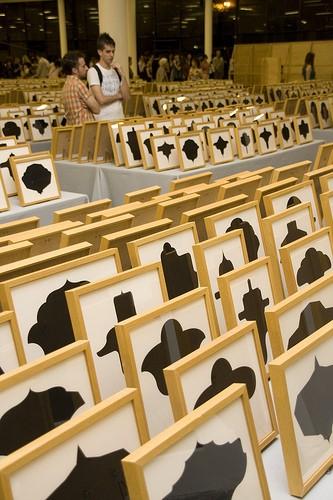|
PROJECTS - 28TH SÃO PAULO BIENAL |
|||||||||

DRAWINGS , 1988/93. Graphite pencil on museum board. Sizes variable, each unique.General view: Centre d' Art Contemporain, Geneva, 1993. (Centre d' Art Contemporain, Geneva) |
|||||||||
|
Allan McCollum
Interview by Lilian Tone Lilian Tone: Like the rest of your work, the 1,800 Drawings beautifully encompass uniqueness and sameness, paradoxically employing mass production as an expressive tool. Can you describe the process that went into their production?
Allan McCollum: There are lots of ways that different people come to consider themselves as belonging to a common group. People can come together under ideas of nationality or religion; people can unite themselves in sharing common interests, or hobbies; people of opposing beliefs can share feelings of unity when they live in the same apartment building, or neighborhood. The very names of places can carry a kind of poetry that brings people together. It's a beautiful process, this establishing of family names, clans, neighborhoods, towns, cities, provinces, states, territories, countries, nations, continents, and worlds. What interests me are the ways an "image" can invite a variety of people to consider themselves within a group, such as can happen with family crests, heraldry, logos, flags, banners, and the like. We unite ourselves with images and symbols, as well as with ideas. This is all wonderful. But I often wish there were more ways to use symbols to help us identify ourselves as individuals. We always seek to belong to a large group and at the same time to define ourselves as one of a kind. It's an eternal paradox. And we also use these same symbols that unite us to divide ourselves from each other. Couldn't a set of symbols be devised that might represent our dreams of unity and our love of diversity, both at the same time? It's a simple idea, creating a system for producing a unique emblematic "shape" for each person on the planet. Of course, it is complicated, and impractical. But since we often think about art as "impossible dreaming," I figured it was okay to try. I hope this installation for the 28th Bienal de São Paulo can help me imagine a larger world than I normally imagine, and maybe help others to do the same. |
|||||||||

